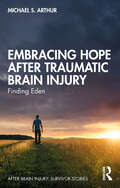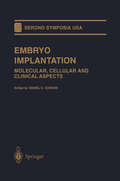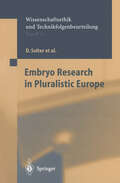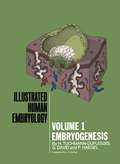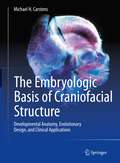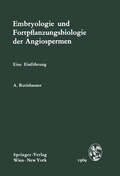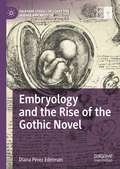- Table View
- List View
Embracing Ethnography: Doing Contextualised Construction Research
by David Oswald Léon Olde ScholtenhuisThis book calls for those interested in robust construction research to embrace ethnography – in all its forms, including rapid ethnographies, ethnographic-action research, autoethnography, as well as longer-term ethnographies.The diversification of ethnographic approaches, as well as ethnographers, will lead to rich insights that can advance the industry theoretically and practically. We share experiences, key considerations and recommendations from leading construction ethnographic researchers from around the world to provide discussion, reflection and understanding into doing ethnography in the construction industry.This book is aimed at academics, students, consultants, editors, reviewers, policymakers, funders and others interested in robust research in the construction industry and built environment but will also be useful for those undertaking research within organisations in other industries.
Embracing Ethnography: Doing Contextualised Construction Research
This book calls for those interested in robust construction research to embrace ethnography – in all its forms, including rapid ethnographies, ethnographic-action research, autoethnography, as well as longer-term ethnographies.The diversification of ethnographic approaches, as well as ethnographers, will lead to rich insights that can advance the industry theoretically and practically. We share experiences, key considerations and recommendations from leading construction ethnographic researchers from around the world to provide discussion, reflection and understanding into doing ethnography in the construction industry.This book is aimed at academics, students, consultants, editors, reviewers, policymakers, funders and others interested in robust research in the construction industry and built environment but will also be useful for those undertaking research within organisations in other industries.
Embracing Hope After Traumatic Brain Injury: Finding Eden (After Brain Injury: Survivor Stories)
by Michael S. ArthurThis important book provides a firsthand account of a university professor who experienced traumatic brain injury. It tells the story of Michael Arthur, who had recently accepted a position as vice principal of a new high school. After only two weeks on the job, he was involved in a car accident while driving through an intersection in northern Utah. Through his personal account, he takes the reader into the dark interworkings of his mind as he tries to cope with his new reality. He provides insight into how he learned how to process information and even speak without stumbling on his words while also sharing how his significant relationships suffered as he tried to navigate the restless seas of doubt while trying to circumvent his unyielding symptoms. The book is about finding optimism and gaining insight into the struggles of the brain-injured patient and about trying to understand the perspectives of loved ones who can’t quite grasp the idea of an invisible injury. From the sudden onset of garbled speech to the challenges of processing information, the changing dynamic of the author’s life is highlighted to help family members and healthcare workers better understand.
Embracing Hope After Traumatic Brain Injury: Finding Eden (After Brain Injury: Survivor Stories)
by Michael S. ArthurThis important book provides a firsthand account of a university professor who experienced traumatic brain injury. It tells the story of Michael Arthur, who had recently accepted a position as vice principal of a new high school. After only two weeks on the job, he was involved in a car accident while driving through an intersection in northern Utah. Through his personal account, he takes the reader into the dark interworkings of his mind as he tries to cope with his new reality. He provides insight into how he learned how to process information and even speak without stumbling on his words while also sharing how his significant relationships suffered as he tried to navigate the restless seas of doubt while trying to circumvent his unyielding symptoms. The book is about finding optimism and gaining insight into the struggles of the brain-injured patient and about trying to understand the perspectives of loved ones who can’t quite grasp the idea of an invisible injury. From the sudden onset of garbled speech to the challenges of processing information, the changing dynamic of the author’s life is highlighted to help family members and healthcare workers better understand.
Embracing Indigenous Knowledge in Science and Medical Teaching (Cultural Studies of Science Education #10)
by Mariana G. HewsonThe focus of the book is on different ways of knowing: the western scientific way (reductionist, dualistic and materialist) versus the indigenous approach (holistic, non-dualistic, and spiritual). It discusses both science and medicine in the context of the challenges experienced in introducing science and medicine into Africa through imperialism, colonization, and globalization. It looks at selected indigenous African paradigms, the dominant western paradigms, and the practitioners that represent these practices. The book deals with questions concerning compatibility and incompatibility of different ways of knowing and delves into epistemological stances, and the assumptions underlying these epistemologies. The volume investigates whether, and how a person can accommodate different epistemologies, and the nature of such accommodations.
Embracing Scientific Realism (Synthese Library #445)
by Seungbae ParkThis book provides philosophers of science with new theoretical resources for making their own contributions to the scientific realism debate. Readers will encounter old and new arguments for and against scientific realism. They will also be given useful tips for how to provide influential formulations of scientific realism and antirealism. Finally, they will see how scientific realism relates to scientific progress, scientific understanding, mathematical realism, and scientific practice.
Embryo Culture: Methods and Protocols (Methods in Molecular Biology #912)
by Gary D. Smith, Jason E. Swain and Thomas B. PoolAssisted reproductive technologies have had a profound impact on biomedical research through transgenic animals, food supply and production, as wells as genetic gain of domestic species, and treatment of human infertility. While significant advances in embryo culture have occurred over the last few decades. In Embryo Culture: Methods and Protocols, expert researchers in the field detail many of the methods which are now commonly used to study human embryo culture. These include emerging methods and the impact of embryo culture on epigenetics and offspring health is presented to set the stage for future research and laboratory application involving embryo culture. Written in the highly successful Methods in Molecular Biology™ series format, chapters include introductions to their respective topics, lists of the necessary materials and reagents, step-by-step, readily reproducible laboratory protocols, and key tips on troubleshooting and avoiding known pitfalls.Authoritative and practical, Embryo Culture: Methods and Protocols seeks to aid scientists in the further study of this crucially important field of embryology and assisted reproductive technologies.
Embryo Implantation: Molecular, Cellular and Clinical Aspects (Serono Symposia USA)
by Daniel D. CarsonEmbryo Models In Vitro: Methods and Protocols (Methods in Molecular Biology #2767)
by Magdalena Zernicka-Goetz Kursad TurksenThis collection explores the use of pluripotent cells to generate early embryo-like structures in vitro, with the resultant 3D embryo-like structures in vitro phenocopying many of the developmental landmarks and 3D architectures seen normally in vivo. The protocols gathered herein cover diverse aspects of the topic and exemplify some of the key developments and improvements in the field. Written for the highly successful Methods in Molecular Biology series, chapters include introductions to their respective topics, lists of the necessary materials and reagents, step-by-step and readily reproducible laboratory protocols, and tips on troubleshooting and avoiding known pitfalls. Authoritative and practical, Embryo Models In Vitro: Methods and Protocols serves as an ideal guide to these exciting and innovative advances in developmental biology.
Embryo Research in Pluralistic Europe (Ethics of Science and Technology Assessment #21)
by D. Solter D. Beyleveld M.B. Friele J. Holówka H. Lilie R. Lovell-Badge C. Mandla U. Martin R. Pardo AvellanedaRecent advances in techniques and understanding in the fields of genetics, embryology and reproductive biology have opened up new ways to treat a wide range of medical problems. They range from new options for infertility treatment and pre-implantation genetic diagnosis to stem-cell-based therapies for debilitating diseases. Since all these approaches involve the manipulation of human gametes, embryos or embryonic cells, and could also permit more contentious uses, they have stimulated a controversial debate as to what aims are desirable and to what extent experiments on human embryos are morally permissible, if permissible at all. The situation is further complicated by the fact that scientific projects are increasingly realized through international co-operation and that patients are increasingly ready to seek morally contentious medical treatment wherever it is available and thus to bypass national legislation. In view of this situation the Europäische Akademie assembled a temporary interdisciplinary project group in which scientists from universities and non-university research organizations in Europe working on the relevant subjects were brought together and charged with establishing a knowledge base and providing suggestions for long-term solutions that would be acceptable for society. Presented here are the results of this project, ranging from a discussion of the theoretical and practical possibilities in human-embryo experimentation and its alternatives in research on adult stem cells, a comparison of the situations and prospects of regulation of embryo research in Europe, a survey of European public attitudes, and a philosophical analysis of the arguments and argumentative strategies used in the debate.
Embryogenesis (Monographien aus dem Gesamtgebiet der Physiologie der Pflanzen und der Tiere #1)
by H. Tuchmann-Duplessis G. David P. HaegelMBRYOLOGY studies the succession of transformations undergone by the fertilized E egg in the formation of a new individual. Development of the embryo is directed by morphogenetic mechanisms ruled by a strict chronology. Survival of the egg, its transport in the genital tract, and the adaptation of the maternal orga nism to its presence are controlled by hormonal actions. Knowledge of these subjects is proving to be increasingly important for the medical practitioner. Such information helps to explain anatomic correlations; organ relation ships also illuminate the etiology of numerous pathologic conditions. Disturbances of prenatal development engender congenital malformations and constitute an important cause of perinatal mortality and postnatal morbidity. Our goal in preparing Volume I was to introduce the student to the complex pheno mena of embryonic development in a clear and direct way. We tried to present an overall view of the simultaneous nature of the multiple and rapid events in embryogenesis. Also, we thought it appropriate to treat certain topics in depth, becallse of their difficulty, or their physiological or pathological implications. Thus, gastrulation and formation of the body shape, including flexion, which are par ticularly dynamic processes, can best be understood by following their sequences in detail. Special attention '}Jas also devoted to the placenta, since it assures the functions of nutrition, respiration, and excretion. It is also an endocrine gland upon which the hor monal equilibrium of pregnancy depends.
Embryogenesis in Mammals (Novartis Foundation Symposia #40)
by Katherine Elliott Maeve O'ConnorThe Novartis Foundation Series is a popular collection of the proceedings from Novartis Foundation Symposia, in which groups of leading scientists from a range of topics across biology, chemistry and medicine assembled to present papers and discuss results. The Novartis Foundation, originally known as the Ciba Foundation, is well known to scientists and clinicians around the world.
Embryogeny and Phylogeny of the Human Posture 1: A New Glance at the Future of our Species
by Anne Dambricourt MalasseThe future of the human posture is in the spotlight. The 200-year-old locomotion paradigm can no longer resist the advancement of knowledge, yet 2,500 years of thinking on the place of verticalized human anatomy and its reflexive consciousness in the natural history of life and the Earth, is more relevant than ever.This book retraces these reflections from pre-Socratic philosophers, focusing on the link between verticality and the most complex and consciously reflexive nervous system on the top rung of the ladder of living beings. The origin of animated forms, or animals, was considered metaphysical until the 19th century but reflection on their inception, from fertilization, paved the way for mathematics of infinitesimal geometry and dynamics. The simian filiation was inconceivable until Jean-Baptiste de Lamarck bridged the gap in 1802 with the locomotion postulate to explain the transition from quadrupedal to bipedal posture, sustained by the hypothesis of inheritance of acquired characteristics. This doctrine was overturned in 1987 by the discovery of the embryonic origins of the straightening - specific dynamics linked to neurogenesis - confirming the natural place of human verticality and nervous system complexity with its psychomotor and cognitive consequences.Sapiens find themselves at the physical limit of the straightening while mechanisms of gametogenesis have never ceased in making neurogenesis exponentially more complex. Is the future exclusively terrestrial or does intrauterine hominization open up new perspectives for space exploration? Posturologists, occlusodontics, osteopaths, cognisciences - all anthropological sciences exposed to human verticality are concerned with this discovery, which allows Sapiens to face their natural destiny
Embryogeny and Phylogeny of the Human Posture 1: A New Glance at the Future of our Species
by Anne Dambricourt MalasseThe future of the human posture is in the spotlight. The 200-year-old locomotion paradigm can no longer resist the advancement of knowledge, yet 2,500 years of thinking on the place of verticalized human anatomy and its reflexive consciousness in the natural history of life and the Earth, is more relevant than ever.This book retraces these reflections from pre-Socratic philosophers, focusing on the link between verticality and the most complex and consciously reflexive nervous system on the top rung of the ladder of living beings. The origin of animated forms, or animals, was considered metaphysical until the 19th century but reflection on their inception, from fertilization, paved the way for mathematics of infinitesimal geometry and dynamics. The simian filiation was inconceivable until Jean-Baptiste de Lamarck bridged the gap in 1802 with the locomotion postulate to explain the transition from quadrupedal to bipedal posture, sustained by the hypothesis of inheritance of acquired characteristics. This doctrine was overturned in 1987 by the discovery of the embryonic origins of the straightening - specific dynamics linked to neurogenesis - confirming the natural place of human verticality and nervous system complexity with its psychomotor and cognitive consequences.Sapiens find themselves at the physical limit of the straightening while mechanisms of gametogenesis have never ceased in making neurogenesis exponentially more complex. Is the future exclusively terrestrial or does intrauterine hominization open up new perspectives for space exploration? Posturologists, occlusodontics, osteopaths, cognisciences - all anthropological sciences exposed to human verticality are concerned with this discovery, which allows Sapiens to face their natural destiny
Embryogeny and Phylogeny of the Human Posture 2: A New Glance at the Future of our Species
by Anne Dambricourt MalasseThe future of the human posture is in the spotlight. The 200-year-old locomotion paradigm can no longer resist the advancement of knowledge, yet 2,500 years of thinking on the place of verticalized human anatomy and its reflexive consciousness in the natural history of life and the Earth, is more relevant than ever.This book retraces these reflections from pre-Socratic philosophers, focusing on the link between verticality and the most complex and consciously reflexive nervous system on the top rung of the ladder of living beings. The origin of animated forms, or animals, was considered metaphysical until the 19th century but reflection on their inception, from fertilization, paved the way for mathematics of infinitesimal geometry and dynamics. The simian filiation was inconceivable until Jean-Baptiste de Lamarck bridged the gap in 1802 with the locomotion postulate to explain the transition from quadrupedal to bipedal posture, sustained by the hypothesis of inheritance of acquired characteristics.This doctrine was overturned in 1987 by the discovery of the embryonic origins of the straightening – specific dynamics linked to neurogenesis – confirming the natural place of human verticality and nervous system complexity with its psychomotor and cognitive consequences. Sapiens find themselves at the physical limit of the straightening while mechanisms of gametogenesis have never ceased in making neurogenesis exponentially more complex. Is the future exclusively terrestrial or does intrauterine hominization open up new perspectives for space exploration? Posturologists, occlusodontics, osteopaths, cognisciences – all anthropological sciences exposed to human verticality are concerned with this discovery, which allows Sapiens to face their natural destiny.
Embryogeny and Phylogeny of the Human Posture 2: A New Glance at the Future of our Species
by Anne Dambricourt MalasseThe future of the human posture is in the spotlight. The 200-year-old locomotion paradigm can no longer resist the advancement of knowledge, yet 2,500 years of thinking on the place of verticalized human anatomy and its reflexive consciousness in the natural history of life and the Earth, is more relevant than ever.This book retraces these reflections from pre-Socratic philosophers, focusing on the link between verticality and the most complex and consciously reflexive nervous system on the top rung of the ladder of living beings. The origin of animated forms, or animals, was considered metaphysical until the 19th century but reflection on their inception, from fertilization, paved the way for mathematics of infinitesimal geometry and dynamics. The simian filiation was inconceivable until Jean-Baptiste de Lamarck bridged the gap in 1802 with the locomotion postulate to explain the transition from quadrupedal to bipedal posture, sustained by the hypothesis of inheritance of acquired characteristics.This doctrine was overturned in 1987 by the discovery of the embryonic origins of the straightening – specific dynamics linked to neurogenesis – confirming the natural place of human verticality and nervous system complexity with its psychomotor and cognitive consequences. Sapiens find themselves at the physical limit of the straightening while mechanisms of gametogenesis have never ceased in making neurogenesis exponentially more complex. Is the future exclusively terrestrial or does intrauterine hominization open up new perspectives for space exploration? Posturologists, occlusodontics, osteopaths, cognisciences – all anthropological sciences exposed to human verticality are concerned with this discovery, which allows Sapiens to face their natural destiny.
The Embryologic Basis of Craniofacial Structure: Developmental Anatomy, Evolutionary Design, and Clinical Applications
by Michael H. CarstensFocusing on the anatomy of the head and neck, this book begins at the cellular level of development, detailing bone, muscle, blood supply, and innervation along the way. It illustrates the origin of each tissue structure to aid in making prognoses beyond the surface deformation, offering typical issues seen in the craniofacial region, for example. Written by a pediatric Craniofacial plastic surgeon and intended for clinicians and residents in the areas of plastic surgery, ENT, maxillofacial surgery, and orthodontistry, this book is the first of its kind to focus so intently on evolution of the craniofacial structure. It is neatly broken up into two distinct sections.The first section is meant for readers to gain a fundamental understanding of the development of craniofacial structures, from embryo onward, relying on the concepts of the Neuromeric Theory. The chapters in the first section of the book trace the development of the typical patient. The second section offers clinical examples of how the Neuromeric Theory can be used to repair or reconstruct various regions of the head and neck. Craniofacial clefts, including cleft lip and palate, ocular hypotelorism, anencephaly, craniosynostosis and more are detailed. Understanding the formation of the tissue structures involved in any given genetic deformation or anomaly enables the clinician to provide a more satisfying outcome for the patient, both structurally and aesthetically. New and current therapeutic options are explored and supported through original illustrations and photographs to aid in determining the best treatment for each individual patient.Embryological Principles of Craniofacial Structure bridges the gap between introductory books on the basic anatomy of the head and neck and the detailed understanding required for corrective surgery of craniofacial defects.
Embryologische Untersuchungen an Zingiberaceen: Inaugural — Dissertation
by Kurt BöhmDieser Buchtitel ist Teil des Digitalisierungsprojekts Springer Book Archives mit Publikationen, die seit den Anfängen des Verlags von 1842 erschienen sind. Der Verlag stellt mit diesem Archiv Quellen für die historische wie auch die disziplingeschichtliche Forschung zur Verfügung, die jeweils im historischen Kontext betrachtet werden müssen. Dieser Titel erschien in der Zeit vor 1945 und wird daher in seiner zeittypischen politisch-ideologischen Ausrichtung vom Verlag nicht beworben.
Embryology and the Rise of the Gothic Novel (Palgrave Studies in Literature, Science and Medicine)
by Diana Pérez EdelmanThis book argues that embryology and the reproductive sciences played a key role in the rise of the Gothic novel in the eighteenth and nineteenth centuries. Diana Pérez Edelman dissects Horace Walpole’s use of embryological concepts in the development of his Gothic imagination and provides an overview of the conflict between preformation and epigenesis in the scientific community. The book then explores the ways in which Gothic literature can be read as epigenetic in its focus on internally sourced modes of identity, monstrosity, and endless narration. The chapters analyze Horace Walpole’s The Castle of Otranto; Ann Radcliffe’s A Sicilian Romance, The Italian, and The Mysteries of Udolpho; Mary Shelley’s Frankenstein; Charles Robert Maturin’s Melmoth the Wanderer; and James Hogg’s Confessions of a Justified Sinner, arguing that these touchstones of the Gothic register why the Gothic emerged at that time and why it continues today: the mysteries of reproduction remain unsolved.
Embryology of Angiosperms
by B. M. JohriThirty-four years have elapsed since the publication of the late Professor P. Maheshwari's text, An Introduction to the Embryology of Angiosperms, a work which for many years served as an invaluable guide for students and a rich source book for research workerso Various texts dealing with sections of the braad spectrum oftopics encompassed by Maheshwari in his book have appeared in the interim, but a compendious modem work dealing with the whole field has been lacking. This present volume splendidly meets the need, and it is altogether fitting that Professor B. M. lohri, long an associate and close colleague of Professor Maheshwari and himself a prolific contributor to the subject, should have undertaken the task of editing it. When Maheshwari wrote, it was stiIl feasible for one author to handIe the subject, but today even someone with his fine bread th of vision and depth of understanding could not, alone, do it justice. So the effort has to be a collaborative one; and Professor lohri's achievement has been to bring together a team of authoritative collaborators, assign them their responsibilities, and put them to work to produce a text as integrated in its treatment as the diversity of the subject would allow. The product vividly illustrates the advances that have been made in the study of angiosperm reproductive systems in the last 30 years, and the book is surely destined to become the new standard for student and researcher alike.
Embryology of Dolphins: Staging and Ageing of Embryos and Fetuses of Some Cetaceans (Advances in Anatomy, Embryology and Cell Biology #157)
by Oldrich Sterba Milan Klima Bernd SchildgerThe rapid development of molecular biology and genetics has led to renewed interest in embryology, comparative embryology, and studies of the relations between ontogeny and phylogeny. In fact, genes have been identified which are involved in the formation of shapes and structures, and it is becoming apparent that their primary morphological expressions are conspicuously similar in different species. The primarily identical shapes do not become diversified until advanced individualization of embryos, and it is here that it is possible to employ the knowledge of comparative embryology, the branch of science engaged in the study of the development and differentiation of tridimensional structures in different animal groups. However, comparative embryology has been neglected during the past decades, as its development has appeared to have been completed. In our opinion, the decreased interest in comparative embryology has been caused by the fact that often the time factor was not or could not be respected. In fact, in the case of embryos of wild animals even their ontogenetic age and sometimes the duration of intrauterine development are unknown.
Embryology of Flowering Plants: Reproductive Systems
by T. B. BatyginaPlant embryology, dealing with the regularities of initiation and the first stages of development of an organism, is now flourishing because of the overall progress being made in natural sciences. Such discoveries of the 20th century as production of plants from a single somatic cell, experimental haploidy, and parasexual hybridization were of general biological significance. The combined efforts of embryologists, geneticists and molecular biologists yielded the discovery of specific genes that control meiosis, egg cell development and early stages of embryogenesis. The tendency to synthesize data of embryology and genetics has become increasingly noticeable. It is connected with the fact that the majority of problems connected with morphogenesis, such as differentiation, specialization, the evaluation of features and the definition of the notionsgene and feature andgenotype and phenotype concern embryology and genetics (embryogenetics) in one way or another. Evolutionary embryology has given rise to a new approach to the study of problems of adaptation in plants. In connection with the problem of preserving biological diversity under conditions of ecological stress, special attention is paid to ecological embryology, revealing the critical periods in early ontogenesis and plasticity and tolerance of reproductive systems at the level of species and population. The study of variability of morphogenesis and phenotype in population (life cycle variations and the diversity of reproductive systems) is the most important point in the population embryology of plants.
Embryology of Flowering Plants: Reproductive Systems
by T. B. BatyginaPlant embryology, dealing with the regularities of initiation and the first stages of development of an organism, is now flourishing because of the overall progress being made in natural sciences. Such discoveries of the 20th century as production of plants from a single somatic cell, experimental haploidy, and parasexual hybridization were of general biological significance. The combined efforts of embryologists, geneticists and molecular biologists yielded the discovery of specific genes that control meiosis, egg cell development and early stages of embryogenesis. The tendency to synthesize data of embryology and genetics has become increasingly noticeable. It is connected with the fact that the majority of problems connected with morphogenesis, such as differentiation, specialization, the evaluation of features and the definition of the notionsgene and feature andgenotype and phenotype concern embryology and genetics (embryogenetics) in one way or another. Evolutionary embryology has given rise to a new approach to the study of problems of adaptation in plants. In connection with the problem of preserving biological diversity under conditions of ecological stress, special attention is paid to ecological embryology, revealing the critical periods in early ontogenesis and plasticity and tolerance of reproductive systems at the level of species and population. The study of variability of morphogenesis and phenotype in population (life cycle variations and the diversity of reproductive systems) is the most important point in the population embryology of plants.

